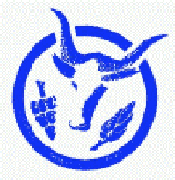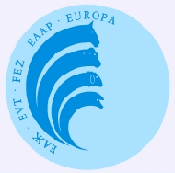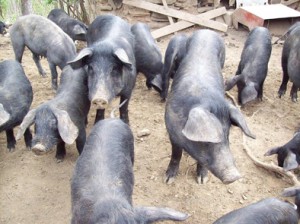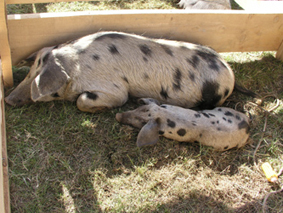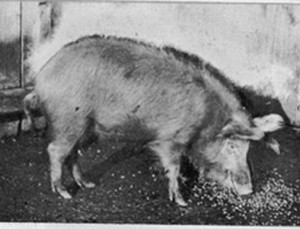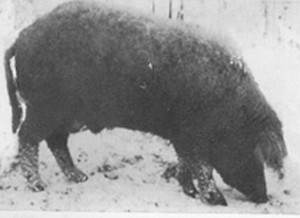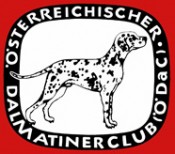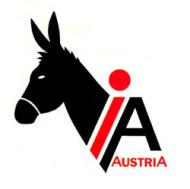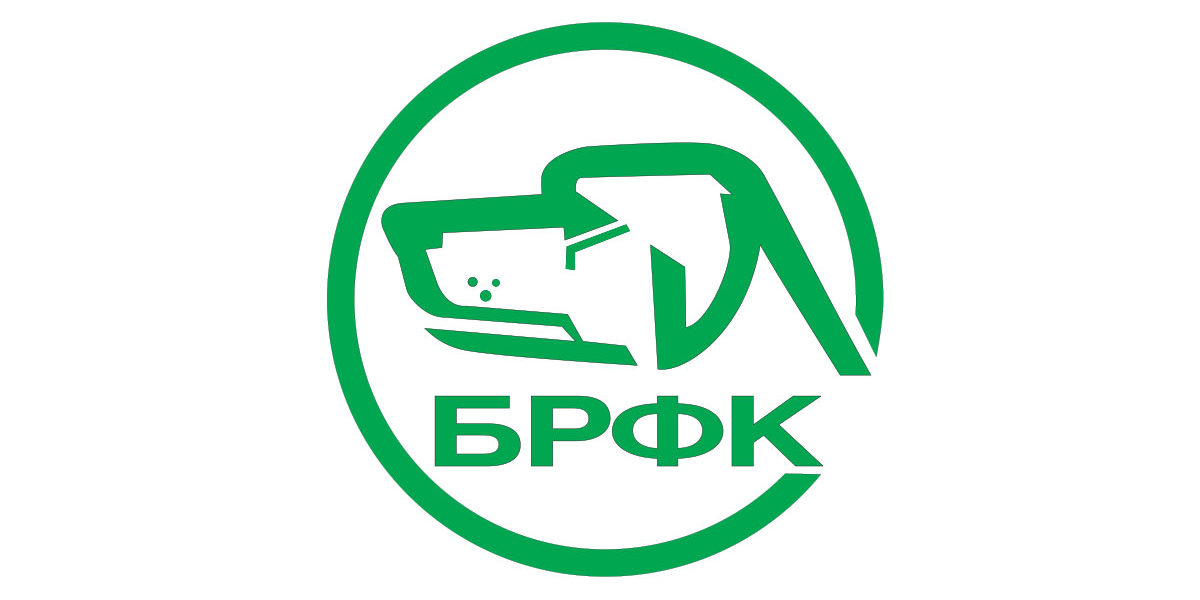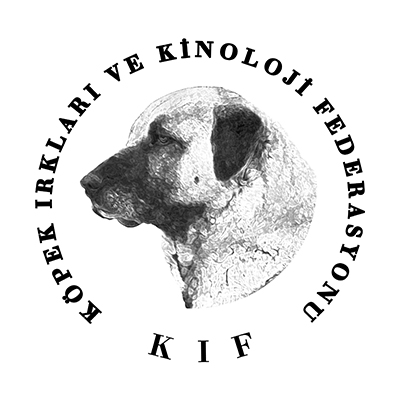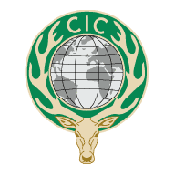Mangulica
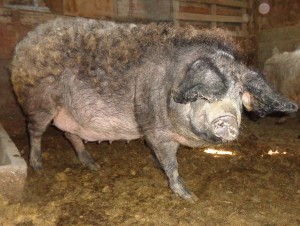 In the 19th century the pig was one of the basic exporting products of Serbia and the origin of the Mangulica is connected with that period. It was recorded that duke Milos gave a certain number of pigs Sumadinka as a present to the Hungarian Archduke Joseph. This pig had been cross-bred at the estate named Kisjenő with types such as the Bakonji and Salantor which resulted in forming of a particular breed called the Mangulica. Due to its exceeding modesty and firmness it was popular in Vojvodina (especially in Srem). Nowadays, the Mangulica is present in Serbia, Hungary, Austria, Germany, Switzerland, Romania and in the territory of ex Czechoslovakia, which speaks about historical aspects of its origin and its popularity. The majority of the countries, excepting Hungary, possesses mainly small and isolated outbred. There are two types of
In the 19th century the pig was one of the basic exporting products of Serbia and the origin of the Mangulica is connected with that period. It was recorded that duke Milos gave a certain number of pigs Sumadinka as a present to the Hungarian Archduke Joseph. This pig had been cross-bred at the estate named Kisjenő with types such as the Bakonji and Salantor which resulted in forming of a particular breed called the Mangulica. Due to its exceeding modesty and firmness it was popular in Vojvodina (especially in Srem). Nowadays, the Mangulica is present in Serbia, Hungary, Austria, Germany, Switzerland, Romania and in the territory of ex Czechoslovakia, which speaks about historical aspects of its origin and its popularity. The majority of the countries, excepting Hungary, possesses mainly small and isolated outbred. There are two types of 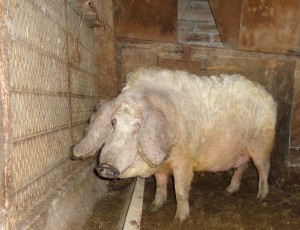 Mangulica in Serbia: the Lasa (the Black Lasa from Srem or Budjanovac pig) and the White. In the area around Subotica the White Subotica type is also present. There is also the so-called the Reddish type in Hungary and Romania.
Mangulica in Serbia: the Lasa (the Black Lasa from Srem or Budjanovac pig) and the White. In the area around Subotica the White Subotica type is also present. There is also the so-called the Reddish type in Hungary and Romania.
Appearance and characteristics:
The Lasa Mangulica has developed in the area of Srem. Dark in colour, with black curly bristles, weighing between 220 and 330 pounds (100-150 kg), and relatively short thorax, it pigs 3 to 6 pigs. White type, in western literature also known as the ‘Hungarian fat pig’ weights around 396 pounds (180kg). The colour of its curly bristles varies from white-grayish to yellowish and it is a bit more fecund than the already mentioned type (5-6 pigs per litter). It has gray pigmented skin. White Subotica type originated from unscientific cross-breeding of the white Mangulica type and the Lincoln or probably the Yorkshire type, thus, this is a more productive and more early-maturing breed (7,5 pigs per litter). Their head is of medium length with mildly indented muzzle; their ears are medium-sized and they fall at the front covering the area around the eyes. The Mangulica’s characteristics are strong bones, strong muscles, earrings on the neck and ragged tail with a tassel. After pigging, piglets have stripes similar to those of a wild boar, but the White type loses them after 10 days and the Lasa Mangulica after 3-4 weeks. They have a great need for moving. The Mangulica is a late-maturing type, slow growing type of a relatively high feed conversion. However, it possesses extraordinary advantages in comparison with other breeds when it comes to free pasturage in the extensive systems of keeping, while its robustness, illness and stress resistance, and hardiness concerning climate conditions is standing out. (Photo: Milivoje Urošević)
Status: Endangered
Population in Serbia: 1000-2000 specimens in 2009 (data source DAD-IS FAO)
_______________________________________________________________________________________
Moravka
The Moravka or Morava pig was developed in the basin of the river Morava by cross-breeding between the local breed Sumadinka with the Berkshire which was imported into Serbia in the late 19th century. Both the Mangulica and Yorkshire took part in the forming of this breed. It was developed in order to create an early-maturing and fleshy pig unlike the Sumadinka which was mostly bred in that area.
Appearance and characteristics:
The head of a Moravka is long and wedge-shaped with semi lop or lop ears. Thorax is long and thin. A hog weighs around 297 pounds (135 kg) and a sow around 264 pounds (120 kg). The skin colour is black-grayish covered in black, thin and smooth bristles. The Moravka belongs to moderate early-maturing fleshy-fat breeds. On average, it pigs 8 piglets but often more. It uses well the food which usually consists of corn, pasture, pumpkins and slops. It fattens up well and the meat is of a good quality. (Photo: Čedomir Radović)
Status: Critically endangered
Population in Serbia: 100-500 specimens in 2009 (data source DAD-IS FAO)
_______________________________________________________________________________________
Resavka
It was developed by unscientific crossing between the Sumadinka and Berkshire in the valleys of the rivers Velika Morava, Mlava and Resava as well as in the eastern highlands of Serbia. The local name for this breed is also ‘vezicevo’ pig. It resembles Moravka in anatomy and characteristics.
Appearance and characteristics:
The body of Resavka is medium long and wide. The head is long and narrow with lop or semi-lop ears. It has mottled skin with yellow-black, thick and smooth bristles. It is categorized as a medium-maturing, fleshy-fat breed. Sows weigh around 308 pounds (140 kg) and hogs around 352 pounds (160 kg). Sows pig 7-8 piglets. This breed uses food well and it is easily fattened up.
Status: Critically endangered
Population in Serbia: 50-100 specimens in 2009 (data source DAD-IS FAO)
_______________________________________________________________________________________
Siska
This primitive indigenous breed of pig got its name, most probably, due to the fringes at the lower part of the neck (people used to call them bangs – siske), what is typical of direct descendants of a European wild boar. Domesticated descendants of a European wild boar were spread in the North and Central Europe. It is assumed that Slavs brought with them the siska’s ancestors to these areas. It had been extensively kept in beech and oak woods as grazing lands. Nowadays, it is believed that this breed has disappeared from these areas and it can hardly be found in remote mountain areas.
Appearance and characteristics:
Its appearance quite resembles a wild boar. The head is big, narrow and long with a straight profile line. The ears are short and pricked and the neck is flat. They have mottled back and steep croup. The anterior part of the body is considerably more developed. The bristles are dense and narrow, white, yellow or brown in colour. The Siska is a late-maturing pig and thus for a complete development it requires up to 3 years. It pigs 4 to 6 piglets per litter. Piglets have ‘livery’- stripes similar to those of a wild boar but which disappear as they grow. Food usage and fatting up are rather poor. (Photo: Album rasa stoke / Livestock Breeds Album by academic Jovan Belic, Naucna knjiga, Beograd 1991)
There are no official data concerning status and population in Serbia.
_______________________________________________________________________________________
Sumadinka
This native breed was named after Serbian area Sumadija where pig breeding was quite developed. The Siska was mainly bred in the highlands, whereas in the plains and river valleys somewhat better breed was kept – sumadinka. They were always kept in natural conditions-in summer time in the grazing lands and in the woods where they stayed until winter because of acorns. Before slaughter, they were fattened up with corn in the pigsties. It is assumed that it has disappeared in these areas. It took part in the creation of the Mangulica, Moravka and Resavka.
Appearance and characteristics:
The Sumadinka is medium-sized and of a coarse constitution. It is covered in curly bristles varying in colour from white yellowish to grey. The head is long and narrow with moderately big and lop ears. Its back is mottled and the croup is steep. The abdomen is round. Fecundity is low. It pigs 3 to 6 piglets which have ‘livery’. Fatting up is poor but this breed is resistant to diseases and adaptable to extensive way of breeding. (Photo: Album rasa stoke / Livestock Breeds Album by academic Jovan Belic, Naucna knjiga, Beograd 1991)
There are no official data concerning status and population in Serbia.
_______________________________________________________________________________________




